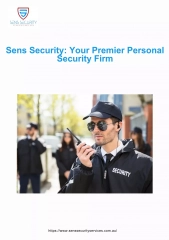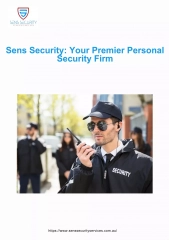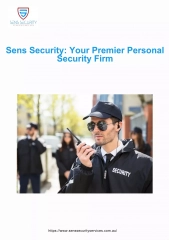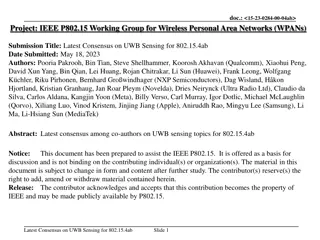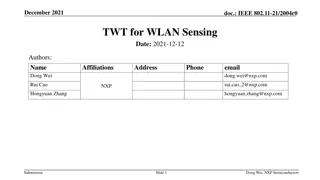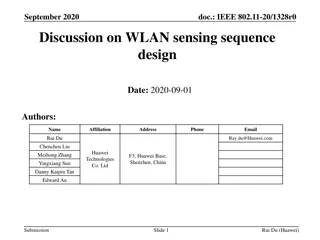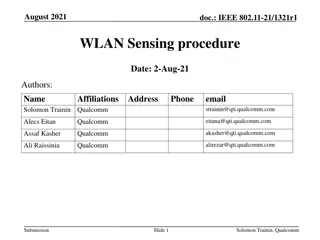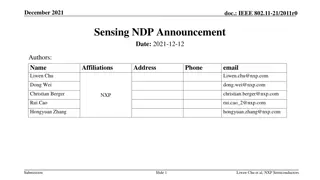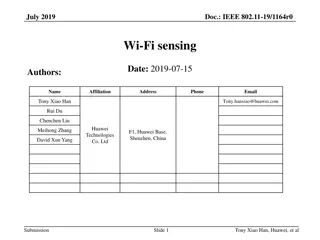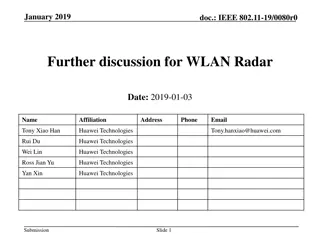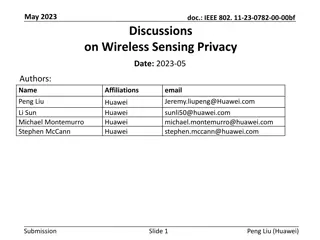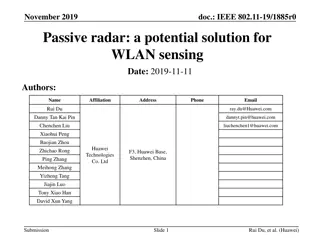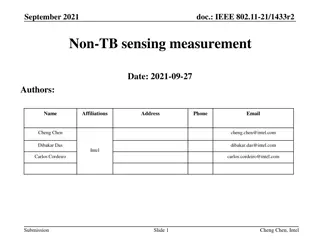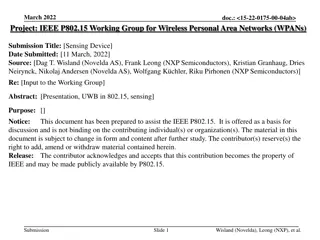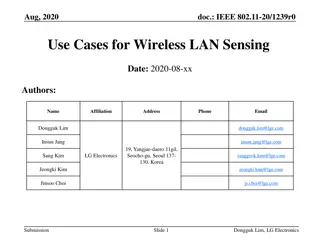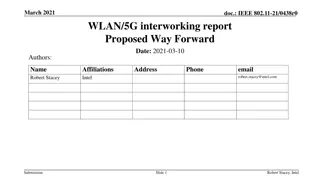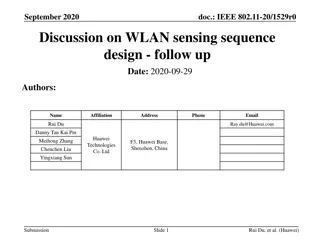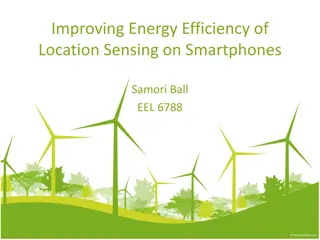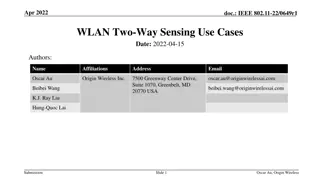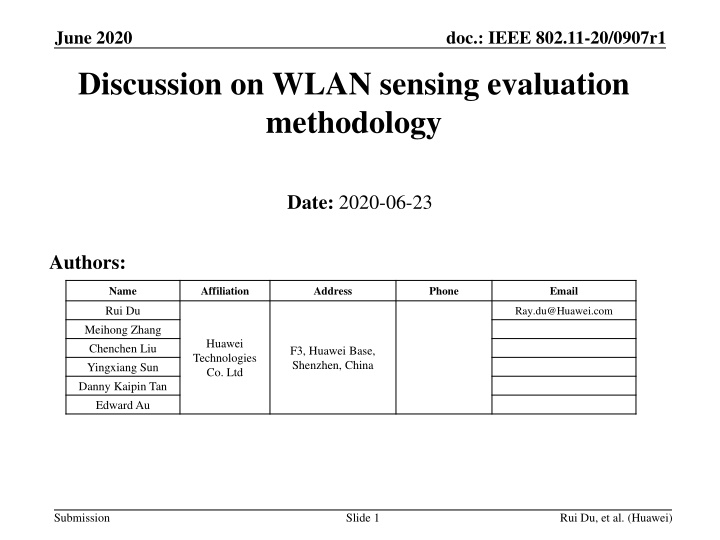
Discussion on WLAN Sensing Evaluation Methodology
Delve into the development process of SENS draft amendment with a focus on evaluation methodology, including examples at 7GHz and 60GHz. Explore channel models, coexistence, functional requirements, and more in the IEEE 802.11-20/0907r1 document presented by Huawei Technologies Co. Ltd.
Download Presentation

Please find below an Image/Link to download the presentation.
The content on the website is provided AS IS for your information and personal use only. It may not be sold, licensed, or shared on other websites without obtaining consent from the author. If you encounter any issues during the download, it is possible that the publisher has removed the file from their server.
You are allowed to download the files provided on this website for personal or commercial use, subject to the condition that they are used lawfully. All files are the property of their respective owners.
The content on the website is provided AS IS for your information and personal use only. It may not be sold, licensed, or shared on other websites without obtaining consent from the author.
E N D
Presentation Transcript
June 2020 doc.: IEEE 802.11-20/0907r1 Discussion on WLAN sensing evaluation methodology Date: 2020-06-23 Authors: Name Affiliation Address Phone Email Rui Du Ray.du@Huawei.com Meihong Zhang Chenchen Liu Yingxiang Sun Danny Kaipin Tan Edward Au Huawei Technologies Co. Ltd F3, Huawei Base, Shenzhen, China Submission Slide 1 Rui Du, et al. (Huawei)
June 2020 doc.: IEEE 802.11-20/0907r1 Outline Abstract The discussion of SENS draft amendment Example1: Evaluation Methodology at sub 7 GHz Example2: Evaluation Methodology at 60 GHz Main contains of evaluation methodology How about for SENS ? Summary References Submission Slide 2 Rui Du, et al. (Huawei)
June 2020 doc.: IEEE 802.11-20/0907r1 Abstract Discussion on SENS draft amendment development process has started during the meeting on April 14[1]. Detail information about evaluation methodology documents from several task groups is provided in this presentation. Some initial ideas about evaluation methodology for SENS is discussed in this slides. Submission Slide 3 Rui Du, et al. (Huawei)
June 2020 doc.: IEEE 802.11-20/0907r1 The discussion of SENS draft amendment The potential documents that SENS SG (or the future TG) would consider[1]. Channel model Evaluation methodology Coexistence Assurance Functional requirements Specification framework Draft Usage model amendment Submission Slide 4
June 2020 doc.: IEEE 802.11-20/0907r1 Example1: Evaluation Methodology at sub 7 GHz TG ac s evaluation methodology and simulation scenarios [2]: PHY performance 1. PHY Channel model(reuse 802.11n). 2. Hardware impairments(reuse 802.11n). 3. Comparison criteria: PER vs. SNR. System performance 1. Traffic models: consider traffic model defined in 802.11n and including high quality videos for VHT and high speed file transfer. 2. Simulation scenarios: in-home entertainment application, enterprise network. 3. Comparison criteria: aggregated throughput, throughput of each flow, packet loss. TG ax s evaluation methodology and simulation scenarios [3]: PHY performance 1. PHY Channel model(an outdoor channel model is added). 2. Hardware impairments. 3. Comparison criteria: PER vs. SNR. System performance 1. Traffic models: full buffer model is baseline, FTP model and mix of small and large packet should also be considered. 2. Simulation scenarios[4]: residential scenario, enterprise scenario, indoor small BSS, outdoor large BSS, outdoor large BSS+residential. 3. Comparison criteria: STA/BSS throughput, packet loss, latency, per STA energy per transmit bit, per STA energy per receive bit. Submission Slide 5 Rui Du, et al. (Huawei)
June 2020 doc.: IEEE 802.11-20/0907r1 Example2: Evaluation Methodology at 60 GHz TG ad s evaluation methodology and simulation scenarios [5]: PHY performance 1. PHY Channel impulse response. 2. Hardware impairments. 3. Comparison criteria: PER vs. SNR. System evaluation 1. Traffic models(high throughput traffic): uncompressed video, lightly compressed video, local file transfer, web browsing, hard disk file transfer. 2. Simulation scenarios: home living room, office conference room, enterprise cubicle. 3. Comparison criteria: goodput (aggregate and per flow), delay, packet loss rate. TG ay s evaluation methodology and simulation scenarios [6]: PHY performance 1. PHY Channel impulse response. 2. Hardware impairments. 3. Comparison criteria: PER vs. SNR. System evaluation 1. Traffic models: lightly compressed video, backhaul traffic, local file transfer, productivity docking, web browsing, hard disk file transfer, gaming. 2. Simulation scenarios: (PHY-layer SLS scenarios) outdoor open area deployment, street canyon, hotel lobby. (MAC-layer SLS scenarios) dense indoor D2D deployment, enterprise cubicle, dense indoor BSS deployment, sparse outdoor BSS deployment. 3. Comparison criteria: goodput (aggregate and per flow), delay, packet loss rate. Submission Slide 6 Rui Du, et al. (Huawei)
June 2020 doc.: IEEE 802.11-20/0907r1 Main contents of evaluation methodology All the examples above on indicate the evaluation methodology documents mainly contain, Channel model to be adopted; Hardware impairment; Traffic model; Simulation scenarios; Comparison criteria for LLS and/or SLS; Submission Slide 7
June 2020 doc.: IEEE 802.11-20/0907r1 How about for SENS ? A new channel model may be needed for sensing simulation A moving target should be included in the channel model for device free sensing. Hardware impairment Could be same with 802.11ax and 802.11ay. Traffic model No traffic model (similar with 11az). Similar traffic model with 11ax and 11ay if communication performance also need to be considered. Simulation scenarios The use cases of SENS SG(or future TG) spans widely, which lead to a large number of simulation scenarios. Which scenarios should be adopted by the group? Comparison criteria for LLS and/or SLS Which performance characteristics should be adopted to evaluate the performance from different contributions? 1. Accuracy, 2. Latency, 3. Submission Slide 8 Rui Du, et al. (Huawei)
June 2020 doc.: IEEE 802.11-20/0907r1 Summary In this slides, the detail structure of evaluation methodology documents from other TGs both at sub 7 GHz and 60 GHz is analyzed. Some initial ideas about the evaluation methodology for SENS are presented and discussed. Submission Slide 9 Rui Du, et al. (Huawei)
May 2020 doc.: IEEE 802.11-20/0907r1 References [1] 11-20-0602-01-SENS-discussion-on-wlan-sensing-draft-amendment-develo pment-process.pptx [2] 11-09-0451-16-00ac-tgac-functional-requirements-and-evaluation-method ology.doc [3] 11-14-0571-12-00ax-evaluation-methodology.docx [4] 11-14-0980-16-00ax-simulation-scenarios.docx [5] 11-09-0296-16-00ad-evaluation-methodology.doc [6] 11-15-0866-04-00ay-11ay-evaluation-methodology.doc Submission Slide 10 Rui Du, et al. (Huawei)

